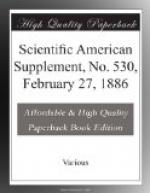The seed business was commenced in Rochester thirty years ago. Later, Mr. Sibley undertook to supply seeds of his own importation and raising and others’ growth, under a personal knowledge of their vitality and comparative value. He instituted many experiments for the improvements of plants, with reference to their seed-bearing qualities, and has built up a business as unique in its character as it is unprecedented in amount. He cultivates the largest farm in the State, occupying Howland Island, of 3,500 acres, in Cayuga County, near the Erie Canal and the New York Central Railroad, which is largely devoted to seed culture; a portion is used for cereals, and 500 head of cattle are kept. On the Fox Ridge farm, through which the New York Central Railroad passes, where many seeds and bulbs are grown, he has reclaimed a swamp of six hundred acres, making of great value what was worthless in other hands, a kind of operation which affords him much delight. His ownership embraces fourteen other farms in this State, and also large estates in Michigan and Illinois.
The seed business is conducted under the firm name of Hiram Sibley & Co., at Rochester and Chicago, where huge structures afford accommodations for the storage and handling of seeds on the most extensive scale. An efficient means for the improvement of the seeds is their cultivation in different climates. In addition to widely separated seed farms in this country, the firm has growing under its directions several thousands of acres in Canada, England, France, Germany, Holland, and Italy. Experimental grounds and greenhouses are attached to the Rochester and Chicago establishments, where a sample of every parcel of seed is tested, and experiments conducted with new varieties. One department of the business is for the sale of horticultural and agricultural implements of all kinds. A new department supplies ornamental grasses, immortelles, and similar plants used by florists for decorating and for funeral emblems. Plants for these purposes are imported from Germany, France, the Cape of Good Hope, and other countries, and dyed and colored by the best artists here. As an illustration of their methods of business, it may be mentioned that the firm has distributed gratuitously, the past year, $5,000 in seeds and prizes for essays on gardening in the Southern States, designed to foster the interests of horticulture in that section.




